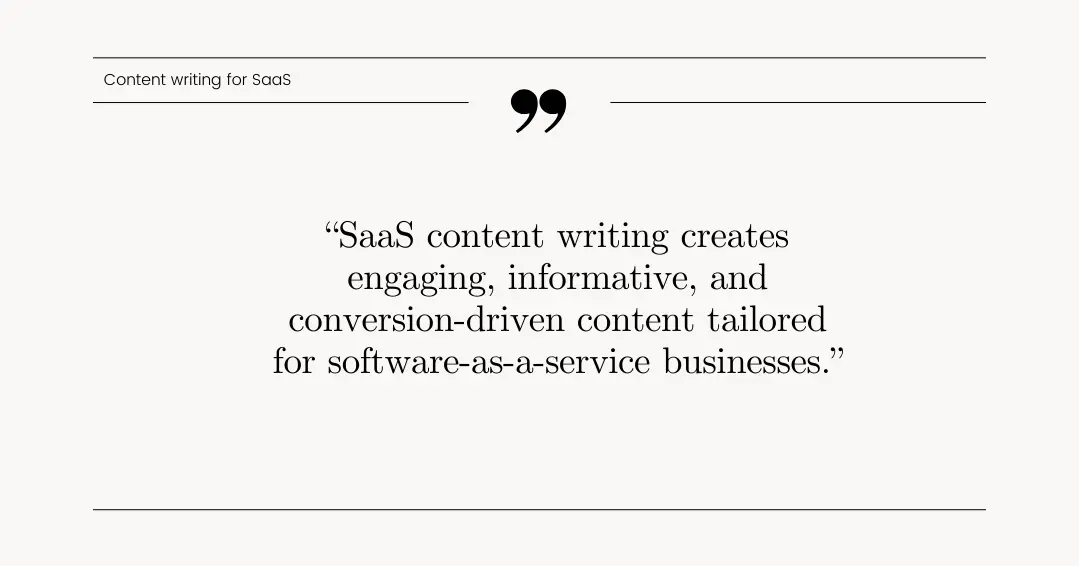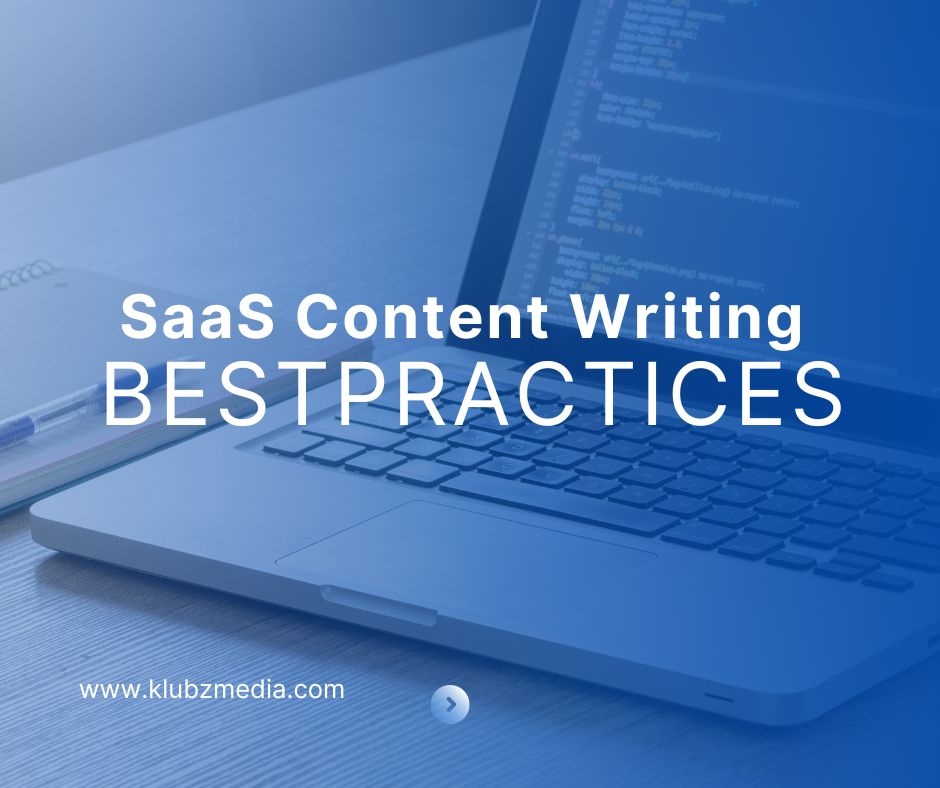SaaS (Software as a Service) content writing differs significantly from other writing forms due to its focus on promoting software solutions. SaaS blogs aim to educate potential users, create product awareness, and drive conversions. Unlike traditional content writing, which may center around general information or storytelling, Content writing for SaaS must balance technical accuracy with persuasive elements. This specialized approach requires writers to deeply understand the software, its target audience, and the industry challenges it addresses.
For instance, a blog post for a SaaS company might highlight how their project management tool can increase team productivity by 30% through features like automated task tracking and real-time collaboration.
It often involves creating detailed user manuals, FAQs, and feature breakdowns to support customer onboarding. In this blog, we will guide you through the basics of SaaS content writing and explain how you can produce the best content for SaaS.
What is SaaS Content Writing?
SaaS content writing is a specialized content strategy for software as a service, detailing the software’s practical advantages for its users. This particular type of content works as a manual for the users. They acquire comprehensive knowledge about the product, beginning with identifying pain points and learning how to utilize SaaS products to resolve them.

Why does the SaaS industry rely heavily on content?
Given the often complex nature of SaaS products, clear and informative content helps demystify the technology, making it more accessible to a broader audience. Here are some more reasons that may show logic to you.
1. Educate and attract customers
SaaS products are often complex and intangible. Unlike a physical product you can hold in your hand, SaaS solutions require explanation and demonstration of value. Content, in various forms like blog posts, articles, ebooks, or webinars, helps educate potential customers about the problems they solve, how their product works, and its benefits. This content establishes the SaaS company as an industry expert and builds trust with potential customers.
2. Drive conversions
Content isn’t just about education; it’s also about driving conversions. Well-crafted content can nurture leads through the sales funnel. It helps to address their pain points and guides them towards a trial or purchase decision.
3. Search Engine Optimization (SEO)
Customers these days have a habit of searching before making any purchase. SaaS companies can improve their search engine ranking by creating high-quality, informative content that targets relevant keywords. Once SEO rankings are improved, it will bring more traffic to websites. This means more potential customers find and learn about their product.
4. Lead generation and conversion
Content acts as a magnet, attracting potential customers who are searching for solutions to their problems. You can show SaaS products’ value proposition through content. It will attract the customer to the product. Eventually, the more leads you have, the more conversions your products will make.
5. Facilitating product adoption
Content empowers users to find solutions independently. Moreover, educational content helps new users quickly get up to speed with the software. It reduces the learning curve and promotes faster adoption and utilization of the product’s features.
Types of written content SaaS marketing should promote
Successfully promoting your software product involves mastering a range of content marketing approaches. Klubz Media specializes in fulfilling all content requirements for SaaS enterprises. So, if you are struggling to produce any of the types given below, feel free to contact us.
- Landing Pages: Targeted web pages designed to capture leads and drive conversions.
- Blog Posts: Regularly updated articles that provide valuable insights, tips, and industry news.
- FAQs and Knowledge Base Articles: Concise answers to common questions and issues.
- Customer Testimonials: Short, impactful quotes or stories from satisfied customers.
- Press Releases: Official announcements about new features.
- Product Guides and Manuals: Detailed instructions on how to use the SaaS product.
- Email Newsletters: Regular updates sent to subscribers.
- Industry Reports and Surveys: Data-driven reports that provide insights into market trends.
- Webinar Summaries and Transcripts: Written summaries and full transcripts of webinars.
- E-books: Extensive guides covering specific topics in-depth.
SaaS content writing best practices
- Product-led Storytelling
- Mastering Topic Selection
- Straight-shooter Content
- Actionable Insights
- Importance of Visuals
- Targeting the Right Audience
- Funnel Content
- Relevancy and Clarity
1. Product-led storytelling
This approach focuses on narrating stories that showcase how your SaaS product solves real-world problems for users. Instead of merely describing features, storytelling emphasizes the practical benefits and outcomes that users can achieve. For example, a case study or customer testimonial that details how a healthcare management SaaS platform streamlined patient scheduling, reducing wait times and improving clinic efficiency.
Best Practices
- Use storytelling formats like case studies, success stories, or user testimonials.
- Highlight specific pain points your product addresses.
- Quantify the benefits whenever possible (e.g., time saved, cost reductions).
- Ensure the narrative is relatable and resonates with your target audience’s challenges.
2. Mastering topic selection
Effective content starts with choosing topics that are relevant and valuable to your target audience. This involves understanding their interests, pain points, and information needs. Conducting keyword research and analyzing customer feedback can help identify topics that are likely to attract traffic.
Best Practices
- Use tools like Google Keyword Planner, SEMrush, or Ahrefs to identify popular search queries related to your SaaS product.
- Leverage customer surveys, social media listening, and feedback from customer support teams to uncover common questions and concerns.
- Prioritize topics that align with your product’s unique selling propositions (USPs) and can showcase your expertise.
3. Straight-shooter content
This principle emphasizes clear and straightforward communication in your content. Avoid technical jargon or complex language that might confuse your audience. The goal is to ensure that your message is easily understood and resonates with your readers’ needs.
Best Practices
- Write in a conversational tone that feels approachable yet informative.
- Break down complex concepts into simple, digestible chunks.
- Provide definitions for technical terms or include tooltips for further explanation.
- Use bullet points or numbered lists to organize information and improve readability.
4. Actionable insights
Content should provide practical advice, tips, or strategies that readers can apply immediately to their situations. This not only demonstrates the value of your expertise but also positions your SaaS product as a solution that drives tangible results.
Best Practices
- Create content formats such as how-to guides, step-by-step tutorials, or actionable checklists.
- Include real-life examples or case studies to illustrate the effectiveness of your recommendations.
- Encourage engagement by inviting readers to share their experiences or ask questions in comments sections or forums.
5. Importance of visuals
Visual content such as images, infographics, charts, and videos can significantly enhance the understanding and engagement of your audience. Visuals help break up text-heavy content, making it more appealing and easier to digest.
Best Practices
- Incorporate relevant visuals that support and reinforce your message. For example, use screenshots or screencasts to demonstrate your software’s interface and features.
- Create infographics to visualize data, statistics, or process flows. Ensure all visuals are high-quality, relevant, and accessible across different devices and platforms.
6. Targeting the right audience
Effective content marketing requires a deep understanding of your target audience’s demographics, preferences, behaviors, and pain points. Tailoring your content to address specific audience segments ensures relevance and enhances engagement.
Best Practices
- Develop detailed buyer personas based on market research, customer data, and feedback.
- Segment your audience based on factors such as industry, job role, company size, or geographic location.
- Create personalized content that speaks directly to each segment’s needs and challenges.
- Use targeted messaging and calls-to-action (CTAs) to guide prospects through the buyer’s journey.
7. Funnel content
Content should align with each stage of the buyer’s journey, from awareness and consideration to decision-making and post-purchase support. Tailoring content to meet the specific needs and expectations of prospects at each stage helps nurture leads and drive conversions.
Best Practices
- Create awareness-stage content that educates and raises awareness of industry challenges or pain points.
- Consideration-stage content should highlight your SaaS product’s unique features and benefits, positioning it as a viable solution.
- Decision-stage content can include product demos, case studies, or free trials to encourage prospects to take the next step.
- Post-purchase content should focus on customer onboarding, training resources, and ongoing support to maximize user retention and satisfaction.
8. Relevancy and clarity
Content must always be relevant, timely, and clear to effectively communicate your message and resonate with your audience. Keeping content up-to-date and aligned with current trends and industry developments helps maintain relevance and credibility.
Best Practices
- Regularly audit and update existing content to ensure accuracy and relevance.
- Monitor industry trends, news, and changes in customer preferences to inform your content strategy.
- Use clear, concise language and structure content logically to enhance readability and comprehension.
- Incorporate visual elements, headers, and formatting to improve clarity and facilitate skimming for key information.
Should SaaS companies opt for outsourcing content creation or manage it internally?
Managing content creation in-house offers several benefits. First, it allows for maintaining brand consistency by having direct control over brand voice, messaging, and content style. This ensures that all content aligns closely with the company’s identity and values.
Second, an internal content team can seamlessly integrate with overall marketing strategies, ensuring that content creation supports broader business objectives and marketing campaigns effectively. Additionally, in-house writers are better positioned to understand and reflect company culture in their content, fostering authenticity and resonance with internal stakeholders and external audiences alike.
However, managing content creation in-house also presents challenges. It can be costly to hire and maintain a dedicated content team, including salaries, benefits, and overhead costs. Secondly, finding the right talent. Workload management poses a challenge, especially for smaller teams, Balancing these benefits and challenges is essential for SaaS companies when determining the most effective approach to content creation.
Outsourcing is a more cost-effective and efficient alternative for SaaS companies to fulfill their content marketing needs.
Hiring freelancers or agencies is often more economical than building and managing an in-house content team. Content marketing agencies typically have access to a diverse pool of writers with specialized knowledge in different fields. It ensures that your content is of high quality and relevance to your target audience. Additionally, outsourcing provides scalability; you can adjust your content output according to your budget and marketing objectives. It will save you time by allowing your internal team to focus on core business functions, leveraging external expertise to handle content creation efficiently.
Final note
To wrap up SaaS content writing best practices, keep your content clear, relevant, and full of practical advice. Stay updated on industry trends and use SEO to make sure people find your content easily. And, do not forget to reach us our for further queries.


